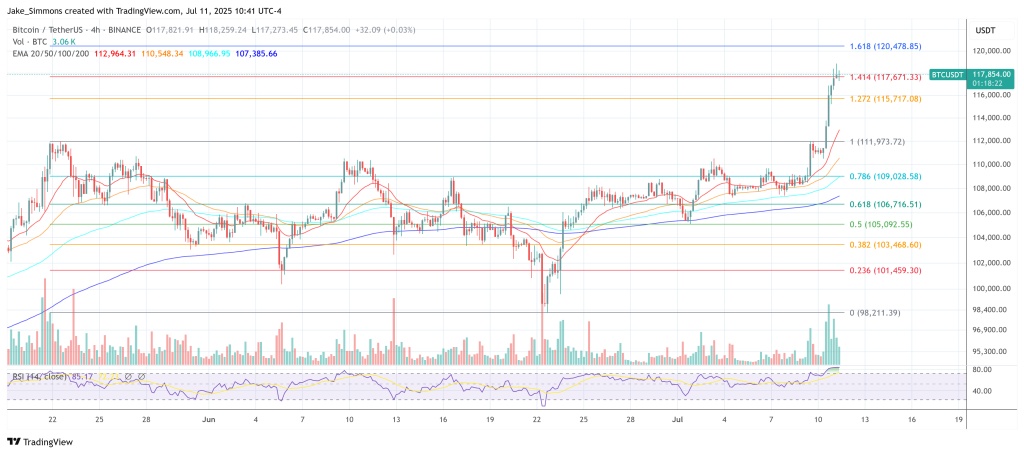Bitcoin Blasts Past $118,800—Legit Rally or a Liquidity Trap for Bulls?
Bitcoin just punched through $118,800 like a bull through a china shop—but is this the real deal or a cleverly disguised trap?
The Breakout Debate
Price action screams 'moon mission,' yet skeptics whisper about overleveraged longs and CEX order books thinner than a trader's patience during consolidation. Liquidity’s hiding like a hedge fund manager during audit season.
Macro vs. Crypto Natives
Traditional finance clings to rate cut hopium while crypto OGs stack sats under the mantra 'number go up.' Meanwhile, Wall Street still can’t decide if BTC is a risk asset or digital gold—classic 'have your cake and short it too' energy.
The Verdict?
Whether this is the start of hyperbitcoinization or just another bull market rug pull, one thing’s certain: the charts won’t lie—but your portfolio might. Trade accordingly (and maybe hedge with some popcorn).
Bitcoin Bull Trap Or Breakout?
Capriole Investments founder Charles Edwards took to X as the breakout unfolded. “New all-time highs beget new ATHs. It’s usually unwise to ignore a major breakout like this, until invalidated,” he wrote, adding that corporate treasury demand has “grown exponentially, with dozens of new companies popping up in recent months.” Edwards’ base-case projection calls for a further 50–70 percent advance over the next six months—roughly $170,000–$196,000.
His focus on treasuries is backed by hard data. Public companies added a record 159,107 BTC in Q2—pushing aggregate corporate holdings above 847,000 BTC, or about four percent of max supply. Corporate Bitcoin acquisitions have even outpaced ETF net inflows.
Matthew Sigel, head of digital-asset research at VanEck, framed Bitcoin’s trajectory within a broader macro and policy backdrop. “The natural course for bitcoin remains higher, driven by persistent US debt and deficit problems, demographic tailwinds, a weakening dollar, growing momentum around Fed rate cuts, and the potential for a new Fed chair next year,” he wrote on X. Sigel also highlighted Capitol Hill’s looming “Crypto Week,” where stablecoin legislation is widely viewed as the most passable of several digital-asset bills. Those developments, he argues, make $180,000 “very much in play for 2025.”
Law-makers appear to share the sense of urgency. A press statement from the House Financial Services Committee confirms that the week of 14 July will be dedicated to advancing the CLARITY Act, the Anti-CBDC Surveillance State Act and the GENIUS Act. Passage WOULD establish the first comprehensive federal framework for stablecoins and market structure, a change Sigel says could “unlock wide-open capital markets” for the sector.
Spot Bitcoin ETFs are hardly idle: net inflows into BlackRock’s iShares fund alone have pushed its holdings past 700,000 BTC in the 18 months since launch. Yet Edwards and Sigel both note that treasury companies have become the marginal buyer in 2025. The dynamic creates what Edwards calls a “cap-raising flywheel,” as firms showcase outperforming share prices—up nearly 60 percent year-to-date for the treasury cohort—when courting investors.
Notably, the rally is unfolding against a supportive macro backdrop. Federal Reserve Governor Christopher Waller told a Dallas Fed audience he is “open to cutting the policy rate in July,” arguing current settings are “too tight” given waning inflation pressures. Meanwhile, US President Donald TRUMP continued his attacks on Fed chair Jerome Powell over the past weeks, demanding immediate rate cuts. Trump’s tariff escalation also seems to fade out, supporting the Bitcoin rally.
Notwithstanding euphoric headlines, technicians warn that momentum must sustain above $110,000 to avoid a failed-breakout pattern. “This theory would be weakened with closes below $110K and invalidated below $105K,” Edwards concludes.
At press time, BTC traded at $117,854.


